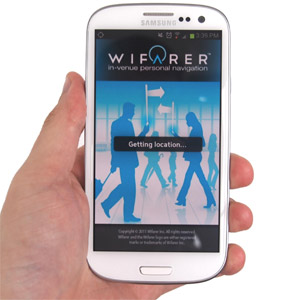 NEWS
NEWS
 NEWS
NEWS
 NEWS
NEWS
![]() The hype over the iOS6 Maps kerfuffle may have subsided but that doesn’t mean people aren’t still making fun of them and other navigation platforms aren’t using this opportunity to shine. But that doesn’t necessarily mean that the focus is all about mapping the outside world.
The hype over the iOS6 Maps kerfuffle may have subsided but that doesn’t mean people aren’t still making fun of them and other navigation platforms aren’t using this opportunity to shine. But that doesn’t necessarily mean that the focus is all about mapping the outside world.
Take for example Wifarer, the company that provides a software only, high-accuracy indoor positioning solution to venues such as airports, shopping centers, museums, convention centers, hospitals, and universities. Though it’s not the same as Google Maps that gives you direction to where you’re heading out in the world, it helps you find your way in an unfamiliar airport or finding your way around a conference venue.
“What makes our solution unique is that it is a complete, customized end-to-end indoor positioning solution,” Wifarer CEO and founder Philip Stanger said in an e-mail interview with SiliconANGLE. “The core of our solution is our technology, which leverages a venue’s existing WiFi system and sensor information from a smartphone to locate a smartphone to an average accuracy of 4.5 feet. Once we know where a smartphone is, we can show the user’s position on a venue map, and give them turn by turn directions from their current location to anywhere within the venue. As they move through the venue, we provide them with relevant high accuracy location based content.”
With Wifarer, users can access information such as flight information and alerts at an airport, exhibit-enhancing multimedia at a museum, seminar schedules at a convention center, coupons at a shopping center, etc. This is possible because any venue with WiFi can quickly and easily deploy Wifarer as it uses signals from the venue’s existing WiFi system to determine the smartphone’s location. Wifarer clients don’t have to purchase, install, or maintain any custom hardware.
What makes Wifarer unique from other indoor positioning tools is that the business model allows venues to control the content and monetization of their digital space online, through their Content Management System (CMS). So for example a shopper is at a mall, and standing in front of Home Depot, Wifarer won’t show the user ads for Lowe’s. Their business model ensures clients both control and profit from any in-app advertising or content placement.
Aside from that, Wifarer’s CMS provides venue administration with analytics to provide valuable insight into visitor traffic and venue usage. The analytics from venues are only available to that venue’s management, and the purpose of the analytics is to enable venues to discover trends so they can better serve their customers.
But the question is, is there a high demand for indoor maps?
According to Stanger, Wifarer’s indoor positioning technology (IPS) is currently changing the way consumers navigate the great indoors while also providing an enhanced visitor experience with turn-by-turn directions, location-based promotions such as coupons and ad pop-ups. And it’s easily adaptable to the unique needs and challenges with each large venue such as directing rushed travelers to gates and terminals to helping museum goers curate their own tours and so on.
“We are seeing a huge demand for our technology from large venues with complex floor plans and those who recognize a value in providing users with real-time wayfinding and location-based content,” Stanger stated. “These types of locations include airports, shopping centers, museums, hospitals, universities, convention centers and sport stadiums.”
Right now, Wifarer has serious traction in the marketplace and have multiple paying clients across Canada and the US such as the Vancouver International Airport, the Royal BC Museum, the University of British Columbia, and other large hospitals, stadia, and convention centers (currently under NDA). They are currently working on growing their network of value added resellers to extend presence and clientele internationally throughout Europe, the Middle East and Asia.
Not to compare Wifarer to Apple’s Maps, but since the topic is still about mapping, the issue regarding Apple wanting a Google-free map can’t be ignored.
“I can certainly understand why Apple would want to have its own mapping system to achieve independence from Google,” Stanger stated. “The mapping-issue has increased media and public interest in the mobile navigation space and given smaller innovative companies like Wifarer the opportunity to shine a light on our areas of strength – high accuracy indoor positioning.”
Google is quite notorious for acquiring private data from the public, especially when they rolled out their Google cars that takes images for the Street View feature of their maps, the topic of privacy and security also came up. According to Stanger, “privacy is of the utmost importance to Wifarer,” and they do not collect any personally information from users. Upon installing the Wifarer app, a unique identifier is installed on the device which cannot be used to determine a user’s identity or any personal information about them. The identifier is used to pair their location request with data from Wifarer in order to facilitate a specific, one-time location transaction. The data they collect from anonymous users are solely used to improve Wifarer’s service.
The Apple Maps kerfuffle left a huge scar on the fruity company’s credibility but that doesn’t mean they won’t recover from it. While Apple is in the process of perfecting their offering, companies like Wifarer, can show Apple how to do things, like focusing on something you are good at. Though unfortunate for Apple, the situation opened doors for companies such as Wifarer, who knows how to handle the mapping business.
THANK YOU